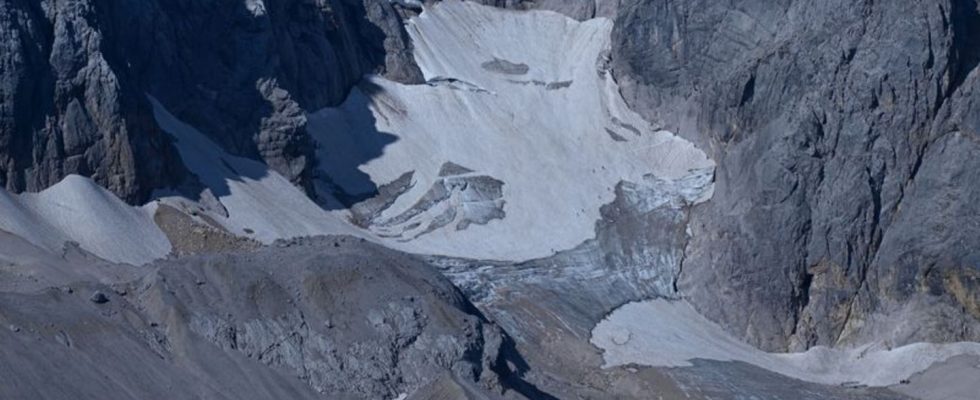Climate change
Glaciers before melting – breathing space in the “dying process”
Scree and remnants of snow lie on the Höllentalferner below the Zugspitze. photo
© Angelika Warmuth/dpa
Climate change is destroying the glaciers. The researchers only give the four remaining glaciers in Germany a few years left. At least there is some good news for the last ice cream near Berchtesgaden.
However, there is no salvation for them. According to researchers from the Bavarian Academy of Sciences (BAdW), the last previously “eternal” ice will have disappeared in about 15 years.
According to new measurements by BAdW scientists, the Watzmann and Blaueis glaciers near Berchtesgaden in particular have lost comparatively little area this summer. What the ice volume looks like is still being evaluated. Ice cover measurement is complex.
“It’s our turn to evaluate the data – and it looks like we didn’t have such a bad summer in Berchtesgaden for the glaciers there,” said glaciologist Christoph Mayer from the BAdW, which prepares a glacier report for the state government every few years . “We still had snow on the glaciers in Berchtesgaden at the end of the season, at least partially.” Snow reflects sunlight and therefore protects the ice. The cold spring with late snowfall probably contributed to the slower melting.
Bad news for the Zugspitze
Things are looking worse this year on Germany’s highest mountain, the Zugspitze. “The areas on the Höllentalferner and the Northern Schneeferner have become significantly smaller,” says Mayer. The Northern Schneeferner in particular suffered. While the Höllentalferner and the Berchtesgaden glaciers are rather shady, they are heavily exposed to the sun.
In July, representatives of the Protestant and Catholic churches invited people to the Requiem for the Northern Schneeferner in the Church of the Visitation of the Virgin Mary on Zugspitzplatt – as a wake-up call for the climate crisis and the dangers to nature and humanity. With death pictures of the decaying glacier with its dirty gray ice, prayers and blessings, the believers celebrated his expected death – pre-posthumously, because according to the current forecast, the Northern Schneeferner still has about seven years to go before it loses its glacier status.
Last year, experts deprived the Southern Schneeferner of its status as the fifth German glacier. At around one and a half hectares – that’s about two football fields – it was half the size of four years before. And: It no longer flows. But flow is a criterion for classifying it as a glacier.
Ice is disappearing faster and faster
The increasing lack of precipitation as snow, along with general warming, is a key factor in the ever faster disappearance of ice. “The less snow we have, the less protected a glacier is,” says Laura Schmidt, science communicator at the Schneefernerhaus environmental research station on the Zugspitze. This year, the warm September and October – the warmest since measurements began at the Zugspitze – took their toll on the ice. “The northern Schneeferner is doing badly.” Schmidt sees the loss every time he looks out the window in the summer.
Cold snaps used to put a protective blanket of snow on the ice for at least a few days, even in summer. But that happens less and less often. Rain above 0 degrees Celsius, high humidity and long periods of sunshine accelerate glacier melting.
Ice reserves may last for two or three years
At the last comprehensive measurement in 2018, the Höllentalferner and Nördlicher Schneeferner – the two largest German glaciers – were just over 16 hectares each, only just under half the size of the Oktoberfest area. The two glaciers in Berchtesgadener Land were around five hectares in size at the time. According to Mayer, the ice reserves there may last for two or three years – or a little longer depending on how the next summer goes. According to the scientists, the summer of 2022 with weeks of sunshine was “devastating”: the melt across the Alps was around 50 percent stronger than in an average year.
The Höllentalferner is the best. It lies in a deep depression and, not least due to its location, is regularly fed by avalanches, at least in the upper part. Scientists assume that it will survive the longest – perhaps until 2035, according to glaciologist Mayer’s cautious forecast. Then Germany will probably be free of glaciers.

